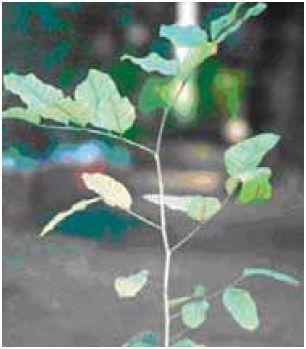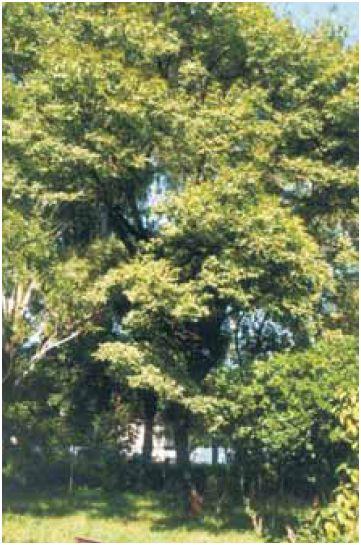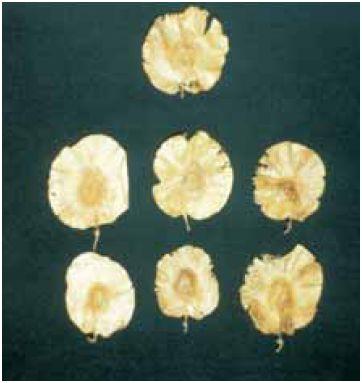Pterocarpus marsupium
Pterocarpus marsupium
Plant Profile
| Family | Fabaceae |
| Ayurvedic name | Bijasar, Asan |
| Unani name | Bijasar |
| Hindi name | Vijaysar,Bijasar |
| Trade name | Vijaysar,Bijasar |
| Parts used | Heartwood,bark,leaves and gum (kino) |

Pterocarpus marsupium - plantlet
Therapeutic uses
- Heartwood of Vijaysar is antibiotic and hypoglycaemic, and is used to control blood sugar.
- Kino gum, obtained from incisions in bark, has astringent, anti-diarrhoeal, and anti-haemorrhagic properties.
- Leaves are used externally to treat boils, sores, and other skin diseases, while flowers are febrifuge.
Morphological characteristics
- Pterocarpus species can be recognized in field by its straight bole, longitudinally fissured bark, imparipinnate and elliptic leaves, fragrant flowers in large panicles, and winged, flat pods.
- The tree reaches up to 30 m in height and up to 2.5 m in girth with straight and clear bole.
- Bark is scaly, rough, and longitudinally fissured.
- Leaflets are generally five to seven in number, 8–13 cm long, oblong or elliptic, or rotund, with 15–20 pairs of lateral veins.
- Oleo-resin obtained from tree trunk is called kino-gum, which is fragrant, brittle, almost black in colour, angular and glistering, and occurs in small flakes.
Floral characteristics
- Fragrant, yellow flowers occur in about 1–5 cm long large panicles.
- Pods are flat, orbicular, winged, and up to 5 cm in diameter.
- Seeds are one to three in number, bony and convex in shape.
- Flowering begins in November, while fruiting continues up to March.
Distribution
- The tree is found in central and peninsular India, chiefly in dry mixed deciduous tropical forests of Gujarat, Madhya Pradesh, and sub- Himalayan tracts, at up to 1000 m altitude. Natural populations have greatly reduced and often no tender young saplings can be found in the forest.
- This is a threatened species on account of autogenic reproductive deficiency.
Climate and soil
- The tree occurs in tropical region and thrives well in open sun under moderate rainfall of 80–200 cm. It prefers fertile, deep clayey loam soil with good drainage.
- It can tolerate excessive temperatures in summer
Varieties
No improved varieties are available, but provenance from Amarkantak showed better growth results during experimentation.
Propagation material
- Freshly collected seeds are used for raising the plantations.
- Mature fruits are plucked from trees in April–May before they fall on ground.

Pterocarpus marsupium - tree
Agro-technique
Nursery technique
Raising propagules
- A nursery is raised from seeds under partial shade in April.
- The plantlets are maintained in the nursery till they are about two months old and then transplanted to the pits in main field during monsoons.
- Seedlings may also be raised in polybags or baskets.
- If seed- lings are maintained till next planting season, it should be ensured that there is no root coiling in the plants.
- Seed viability is very low (about 1%–2%) and hence this tree has been put under threatened species grade ‘A’.
- Seedlings raised from tissue culture die out and their survival rate is hardly 10% in open field due to intolerance of high temperature, hence winter is a preferred season for transplantation of tissue-culture-raised plants in field.
Propagule rate and pretreatment
- About 100 g of viable seeds are required to raise seedlings on 1 hectare of land for planting at 8 m × 8 m spacing.
- Before sowing, seeds are treated with Thiram @ 3 g/kg of seeds to protect them from fungal infections.
- Germination can be hastened by cutting across their ends and soaking them in water for two days before sowing.
- Freshly collected seeds should be protected from seed borers.
Planting in the field
Land preparation and fertilizer application
- Land is made into fine tilth by ploughing and harvesting in April–May.
- Pits of appropriate size (50 cm × 50 cm) are dug at a spacing of 8 m × 8 m.
- About 25 kg FYM (farmyard manure), along with 200 g of nitrogen and 150 g of phosphorus, is mixed with soil of each pit as basal dose.
- The pits are refilled with this mixture after weathering of soil.
Transplanting and optimum spacing
- Transplanting may either be done in July–August (monsoon season) when the plants are two-month-old or delayed till next June–July.
- A spacing of 8 m × 8 m is recom- mended, which accommodates about 160 plants per hectare.
- Gap filling in the field is done in September.
Intercropping system
- When Bijasar is planted planting at a spacing of 8 m × 8 m, intercropping can be done with a number of species such as medicinal plants and vegetable crops.
- The species can also be raised as a pure crop at smaller spacing.
Interculture and maintenance practices
- FYM @ 25 kg per plant, nitrogen @ 200 g/plant, and phosphorus @ 150 g/plant are required every year for the first three years.
- The fertilizer is applied in two split doses, the first in September and the second in January.
- Two manual weedings, the first one in August and the second in November, are recommended.
Irrigation practices
- Irrigation should be done six times in the first year (preferably once a month) through check basin system or filling the basin of the pit with water.
Disease and pest control
- No serious insect pest and disease are observed in mature stems and roots.
- However, seeds are prone to seed borer, which decreases seed viability.
- This can be controlled to some extent by proper drying (up to 12% moisture) and using carbon-di-sulphide in storage.
- In nursery and early growth stages, leaf-eating insects and white grub attack are often reported, which can be controlled by four sprays of Endosulphan @ 0.003% at fortnightly intervals and application of Phorate 10 G near the root zone, respectively.
- To keep the plants disease-free in nursery and early stages of development in the field, seed treatment with Thiram @ 3 g/kg of seed is essential.

Pterocarpus marsupium - seeds
Harvest management
Crop maturity and harvesting
- The tree is harvested after 10–15 years for production of heartwood.
- Kino gum is collected through incision in the bark before logging of tree, and dried well in shade.
Chemical constituents
- Isoflavanoids, terpenoids, and tannis are reported from heartwood.
- Roots contain liquid-ritigenin, garbanzol, pterosupin, pseudo-dobatigenin, and 5-deoxy-kaempferol.
- Kino gum contains kitannic acid.
Yield
- Each mature tree yields approximately 500 kg of dry heartwood after 10–15 years.
- Thus, an estimated yield of 750–800 quintals/hectare is obtained.
Source : Agro-techniques of selected medicinal plants
Last Modified : 6/27/2024
This topic provides information about cultivation ...
This content provides information about cultivatio...
This content provides information about cultivatio...
This topic provides information about cultivation ...
